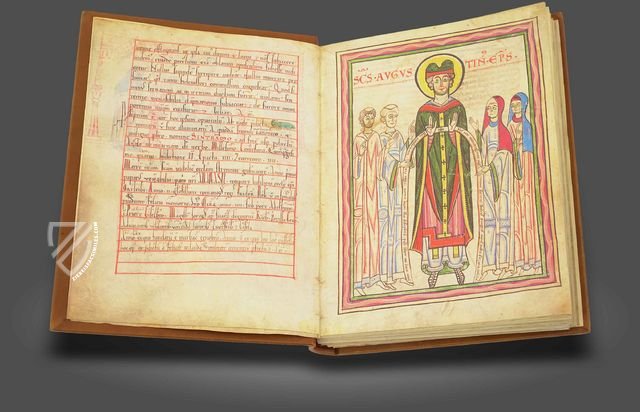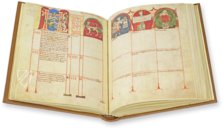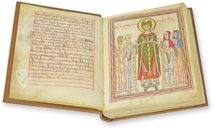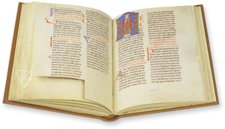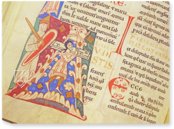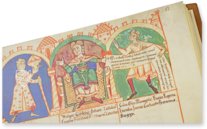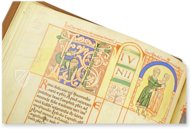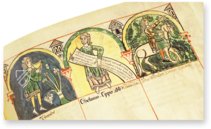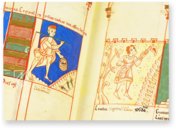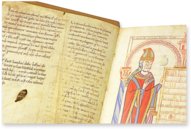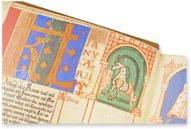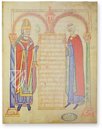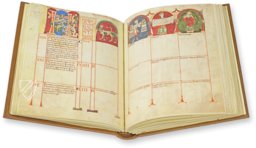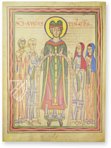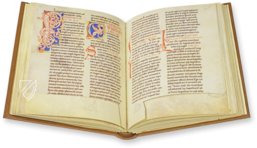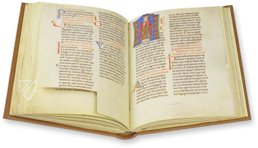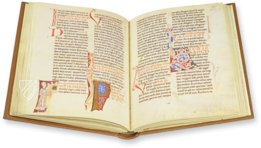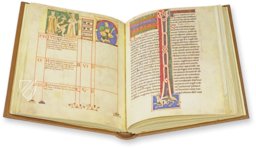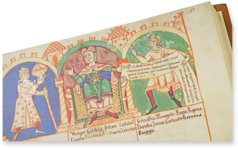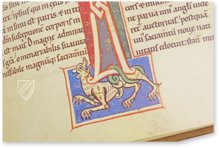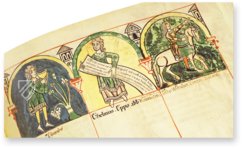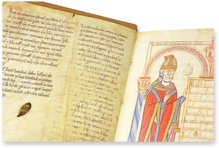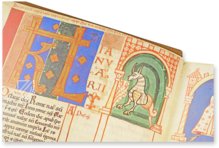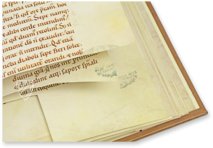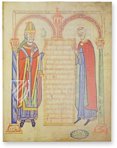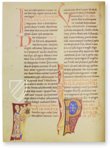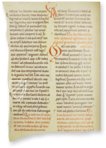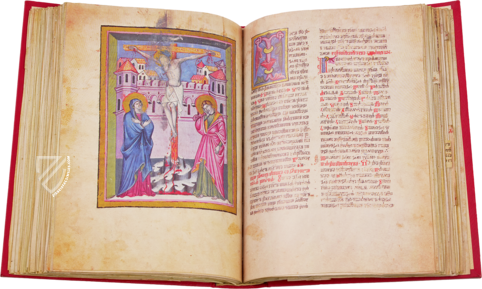Guta-Sintram Codex
(1,000€ - 3,000€)
The Guta-Sintram Codex is a compilation resulting from an extraordinary collaboration that gives a unique glimpse into the world of a Romanesque cloister. It was completed in 1154 by Canoness Guta von Schwarzenthann and Canon Sintram, both members of the Augustinian Order of the Marbach Abbey in Alsace. Next to the prayer texts, legal decisions, and important information about monastic life, the work gives medical advice and is especially famous for its lavishly adorned, humorous monthly calendar. It is richly adorned with 230 colored miniatures including 3 full-page miniatures, 26 historiated initials, and numerous smaller initials including 35 double-page illustrations decorated with large initials, banderoles, zodiac signs, and groups of people. The Guta Sintram Codex is one of the most precious Alsatian manuscripts ever created and is considered to be a treasure of European culture because of its age, its exceptional Romanesque illumination, and its contents.
Guta-Sintram Codex
In 1154, an incomparable manuscript emerged from the Marbach Monastery in the Upper Alsace region. It is a combination of a a prayer book, a law book, a necrology, a collection of sermons, and an especially lavishly designed calendar. The 326-page work is richly ornamented with an artistic core of 70 pages presenting a comprehensive monthly calendar with medical advice, which represents a true masterpiece of early book illustration. The codex is probably the costliest manuscript from Alsace and belongs to the cultural heritage of the European Middle Ages.
A Gifted Duo
The Guta-Sintram Codex was the result of an exceptional collaboration and is named after both of its authors. The duo consisted of Guta von Schwarzenthann, a canoness, and Canon Sintram, both of them were members of the Augustinian Order of the Marbach cloister in Alsace. Guta is responsible for the beautiful script while the wonderful full page illustrations and countless decorative initials come from Sintram. They completed the work in 1154 and dedicated it to the Virgin Mary. The Marbach cloister was founded in 1089 and was the springboard for the founding of important cloisters in the Upper Rhine region of southern Germany and Switzerland.
A Surprising Wealth of Information
The codex was originally compiled as a prayer book for the women of the Schwarzenthann cloister. It offered and still offers much more than a collection of prayers and liturgical texts. The work contains references to the lifestyle of the women of the cloister, it contains a transcript of the papal privileges of the convent and also offers its legal basis, a register of martyrs and other saints, as well as a register of the deceased abbots, provosts, monks, prioresses, and nuns of the cloister. Furthermore, a collection of sermons corresponding to the readings of the day are to be found in the work as well as a collection of the customs and practices of the cloister. There is no other work from this time, that makes such a detailed glimpse of daily cloister life in that time possible.
An Artwork of Illumination
There are many admirable, at times full-page miniatures of extraordinary quality in the book, but the layout of the calendars truly gives proof of Canon Sintram’s talents. The 35 double-page illustrations are decorated with large initials, banderoles, zodiac signs, and groups of people. The banderoles provide instructions for bloodletting, give dietary advice, or recommend medicines derived from plants or animals. The monthly calendar is lovingly crafted with jokes and humor and depicts a truly unique glimpse into the monastic medicine of the Middle Ages.
Codicology
- Alternative Titles
- Codex Guta-Sintram
- Size / Format
- 326 pages / 35.5 × 27.0 cm
- Origin
- France
- Date
- 1154
- Epochs
- Style
- Language
- Script
- Protogothic
- Illustrations
- 230 colored miniatures including 3 full-page miniatures, 26 historiated initials, numerous smaller initials
- Content
- Comprehensive monthly calendar with medical advice, prayer texts and sermons; legal decisions, privileges and charters; martyrology; necrology, customs, and practices of the cloister
- Artist / School
- Guta von Schwarzenthann (scribe)
Sintram von Marbach (illuminator) - Previous Owners
- Convent of Schwartzenthann
Marbach Abbey
Guta-Sintram Codex
“P“ Initial with Dragon
Aside from the manuscript’s humorous calendar pages and elaborate full-page miniatures, the décor of the text pages is extraordinary. Here we see a golden “P” initial with diamond-patterned silver bands and a green-blue-red filigree background. A winged dragon with a second head on the end of its tail is depicted climbing up between the columns of text in red, yellow, and orange. The clear, uniformly-written text in black and red ink completes the perfection of this Romanesque masterpiece.

Guta-Sintram Codex
Portrait of St. Augustine
This manuscript originated from the Upper Alsace region, specifically in Marbach Monastery, an Augustinian monastic community. As such, here we find the obligatory miniature dedicated to the founder of the order, St. Augustine. Even though the order would not formally be founded for another century, this 12th century manuscript contains inter alia the Rule of St. Augustine.
This rare Romanesque portrait is evocative of an Evangelist portrait in the Insular style and presents the saint flanked by two nuns and two tonsured monks. In comparison to the smaller, lightly shaded figures to the left and right, St. Augustine is portrayed front and center in rich primary colors. His eyes are fixed upward and his expression is sublime.

#1 Codex Guta-Sintram
Languages: French, German
(1,000€ - 3,000€)
- Treatises / Secular Books
- Apocalypses / Beatus
- Astronomy / Astrology
- Bestiaries
- Bibles / Gospels
- Chronicles / History / Law
- Geography / Maps
- Saints' Lives
- Islam / Oriental
- Judaism / Hebrew
- Single Leaf Collections
- Leonardo da Vinci
- Literature / Poetry
- Liturgical Manuscripts
- Medicine / Botany / Alchemy
- Music
- Mythology / Prophecies
- Psalters
- Other Religious Books
- Games / Hunting
- Private Devotion Books
- Other Genres
- Afghanistan
- Armenia
- Austria
- Belgium
- Colombia
- Croatia
- Cyprus
- Czech Republic
- Denmark
- Egypt
- Ethiopia
- France
- Germany
- Greece
- Hungary
- India
- Iran
- Iraq
- Israel
- Italy
- Japan
- Lebanon
- Luxembourg
- Mexico
- Morocco
- Netherlands
- Palestine
- Peru
- Poland
- Portugal
- Russia
- Serbia
- Spain
- Sri Lanka
- Sweden
- Switzerland
- Syria
- Turkey
- Ukraine
- United Kingdom
- United States
- Uzbekistan
- Aboca Museum
- Ajuntament de Valencia
- Akademie Verlag
- Akademische Druck- u. Verlagsanstalt (ADEVA)
- Aldo Ausilio Editore - Bottega d’Erasmo
- Alecto Historical Editions
- Alkuin Verlag
- Almqvist & Wiksell
- Amilcare Pizzi
- Andreas & Andreas Verlagsbuchhandlung
- Archa 90
- Archiv Verlag
- Archivi Edizioni
- Arnold Verlag
- ARS
- Ars Magna
- ArtCodex
- AyN Ediciones
- Azimuth Editions
- Badenia Verlag
- Bärenreiter-Verlag
- Belser Verlag
- Belser Verlag / WK Wertkontor
- Benziger Verlag
- Bernardinum Wydawnictwo
- BiblioGemma
- Biblioteca Apostolica Vaticana (Vaticanstadt, Vaticanstadt)
- Bibliotheca Palatina Faksimile Verlag
- Bibliotheca Rara
- Boydell & Brewer
- Bramante Edizioni
- Bredius Genootschap
- Brepols Publishers
- British Library
- C. Weckesser
- Caixa Catalunya
- Canesi
- CAPSA, Ars Scriptoria
- Caratzas Brothers, Publishers
- Carus Verlag
- Casamassima Libri
- Chavane Verlag
- Christian Brandstätter Verlag
- Circulo Cientifico
- Club Bibliófilo Versol
- Club du Livre
- CM Editores
- Collegium Graphicum
- Collezione Apocrifa Da Vinci
- Comissão Nacional para as Comemorações dos Descobrimentos Portugueses
- Coron Verlag
- Corvina
- CTHS
- D. S. Brewer
- Damon
- De Agostini/UTET
- De Nederlandsche Boekhandel
- De Schutter
- Deuschle & Stemmle
- Deutscher Verlag für Kunstwissenschaft
- DIAMM
- Droz
- E. Schreiber Graphische Kunstanstalten
- Ediciones Boreal
- Ediciones Grial
- Ediclube
- Edições Inapa
- Edilan
- Editalia
- Edition Deuschle
- Edition Georg Popp
- Edition Leipzig
- Edition Libri Illustri
- Editiones Reales Sitios S. L.
- Éditions de l'Oiseau Lyre
- Editions Medicina Rara
- Editorial Casariego
- Editorial Mintzoa
- Editrice Antenore
- Editrice Velar
- Edizioni Edison
- Egeria, S.L.
- Eikon Editores
- Electa
- Emery Walker Limited
- Enciclopèdia Catalana
- Eos-Verlag
- Ephesus Publishing
- Ernst Battenberg
- Eugrammia Press
- Extraordinary Editions
- Fackelverlag
- Facsimila Art & Edition
- Facsimile Editions Ltd.
- Facsimilia Art & Edition Ebert KG
- Faksimile Verlag
- Feuermann Verlag
- Folger Shakespeare Library
- Franco Cosimo Panini Editore
- Friedrich Wittig Verlag
- Fundación Hullera Vasco-Leonesa
- G. Braziller
- Gabriele Mazzotta Editore
- Gebr. Mann Verlag
- Gesellschaft für graphische Industrie
- Getty Research Institute
- Giovanni Domenico de Rossi
- Giunti Editore
- Graffiti
- Grafica European Center of Fine Arts
- Guido Pressler
- Guillermo Blazquez
- Gustav Kiepenheuer
- H. N. Abrams
- Harrassowitz
- Helikon
- Hendrickson Publishers
- Henning Oppermann
- Herder Verlag
- Hes & De Graaf Publishers
- Hoepli
- Holbein-Verlag
- Hortus Deliciarum
- Houghton Library
- Hugo Schmidt Verlag
- Idion Verlag
- Il Bulino, edizioni d'arte
- ILte
- Imago
- Insel Verlag
- Instituto Nacional de Antropología e Historia
- Istituto dell'Enciclopedia Italiana - Treccani
- Istituto Ellenico di Studi Bizantini e Postbizantini
- Istituto Geografico De Agostini
- Istituto Poligrafico e Zecca dello Stato
- Italarte Art Establishments
- J. Thorbecke
- Jan Thorbecke Verlag
- Johnson Reprint Corporation
- Josef Stocker
- Josef Stocker-Schmid
- Jugoslavija
- Karl W. Hiersemann
- Kasper Straube
- Kaydeda Ediciones
- Kindler Verlag / Coron Verlag
- Kodansha International Ltd.
- Konrad Kölbl Verlag
- Kurt Wolff Verlag
- La Liberia dello Stato
- La Linea Editrice
- La Meta Editore
- Lambert Schneider
- Landeskreditbank Baden-Württemberg
- Leo S. Olschki
- Les Incunables
- Library of Congress
- Libreria Musicale Italiana
- Lichtdruck
- Lito Immagine Editore
- Lumen Artis
- Lund Humphries
- M. Moleiro Editor
- Maison des Sciences de l'homme et de la société de Poitiers
- Manuscriptum
- Martinus Nijhoff
- Maruzen-Yushodo Co. Ltd.
- MASA
- McGraw-Hill
- Militos
- Millennium Liber
- Müller & Schindler
- Nahar and Steimatzky
- National Library of Wales
- Neri Pozza
- Nova Charta
- Oceanum Verlag
- Odeon
- Orbis Mediaevalis
- Orbis Pictus
- Österreichische Staatsdruckerei
- Oxford University Press
- Pageant Books
- Parzellers Buchverlag
- Patrimonio Ediciones
- Pattloch Verlag
- PIAF
- Pieper Verlag
- Plon-Nourrit et cie
- Prestel Verlag
- Princeton University Press
- Prisma Verlag
- Priuli & Verlucca, editori
- Pro Sport Verlag
- Propyläen Verlag
- Pytheas Books
- Quaternio Verlag Luzern
- Reales Sitios
- Recht-Verlag
- Reichert Verlag
- Reichsdruckerei
- Riehn & Reusch
- Roberto Vattori Editore
- Rosenkilde and Bagger
- Roxburghe Club
- Salerno Editrice
- Sarajevo Svjetlost
- Schöck ArtPrint Kft.
- Scolar Press
- Scrinium
- Scripta Maneant
- Scriptorium
- Siloé, arte y bibliofilia
- SISMEL - Edizioni del Galluzzo
- Sociedad Mexicana de Antropología
- Société des Bibliophiles & Iconophiles de Belgique
- Soncin Publishing
- Sorli Ediciones
- Stainer and Bell
- Studer
- Styria Verlag
- Sumptibus Pragopress
- Szegedi Tudomànyegyetem
- Taberna Libraria
- Tarshish Books
- Taschen
- Tempus Libri
- Testimonio Compañía Editorial
- Thames and Hudson
- The Clear Vue Publishing Partnership Limited
- The Facsimile Codex
- The Folio Society
- The Marquess of Normanby
- The Richard III and Yorkist History Trust
- Tip.Le.Co
- TouchArt
- TREC Publishing House
- TRI Publishing Co.
- Trident Editore
- Typis Regiae Officinae Polygraphicae
- Union Verlag Berlin
- Universidad de Granada
- University of California Press
- University of Chicago Press
- Urs Graf
- Vallecchi
- Van Wijnen
- VCH, Acta Humaniora
- VDI Verlag
- VEB Deutscher Verlag für Musik
- Verlag Anton Pustet / Andreas Verlag
- Verlag Bibliophile Drucke Josef Stocker
- Verlag der Münchner Drucke
- Verlag für Regionalgeschichte
- Verlag Styria
- Vicent Garcia Editores
- W. Turnowsky
- Waanders Printers
- Wiener Mechitharisten-Congregation (Wien, Österreich)
- Wissenschaftliche Buchgesellschaft
- Wydawnictwo Dolnoslaskie
- Xuntanza Editorial
- Zakład Narodowy
- Zollikofer AG

